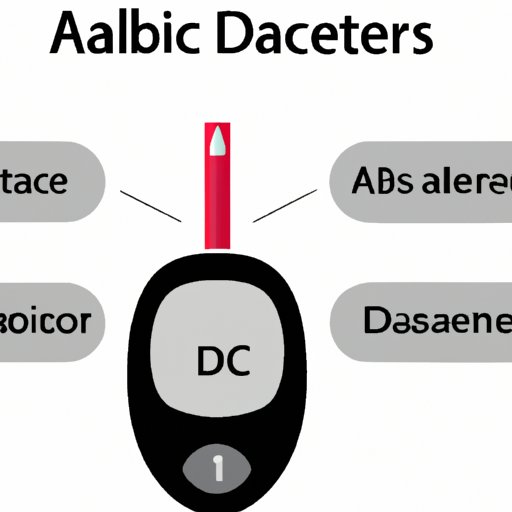
Introduction
Diabetes is a chronic condition that affects millions of people worldwide. While diabetes is a manageable illness, it’s crucial to diagnose it early to prevent severe, long-term complications. Early diagnosis of diabetes is achieved through a combination of recognizing common symptoms and understanding your blood sugar levels. In this article, we will provide a comprehensive guide to detecting diabetes early, including common symptoms, risk factors, diagnostic tests, and self-monitoring techniques.
10 Common Symptoms of Diabetes: A Guide for Early Diagnosis
One of the most visible indications of diabetes is a combination of the following ten symptoms:
- Frequent urination
- Excessive thirst
- Unusual hunger or increased appetite
- Unexplained weight loss
- Increased fatigue and lethargy
- Sudden blurred vision
- Dry mouth and itchy skin
- Slow healing cuts or bruises
- Numbness or tingling in the limbs
- Frequent infections, including gum or bladder infections
If you experience one or more of these symptoms, it’s best to seek medical attention as early as possible.
Understanding Blood Sugar Levels: How to Detect Diabetes Early
Blood sugar levels are instrumental in identifying diabetes in its early stages. Typically, blood sugar levels rise after eating or drinking and fall when fasting. The American Diabetes Association suggests that blood glucose levels should fall between 70 to 130 milligrames per deciliter (mg/dL) before meals and below 180 mg/dL two hours after eating.
Abnormal blood sugar levels may indicate prediabetes, gestational diabetes, or type 1 or 2 diabetes. Prediabetes indicates a high risk of developing type 2 diabetes, while gestational diabetes occurs during pregnancy. Diabetes can be diagnosed with an A1C blood test, fasting blood sugar test, or oral glucose tolerance test.
The Importance of Regular Checkups: Identifying Diabetes in Its Early Stages
Regular checkups are essential in detecting diabetes in its early stages, especially for people over 45 years old, overweighted people, and women with a history of gestational diabetes. During these checkups, healthcare providers may perform routine blood work, such as lipid profiles and A1C tests, or inquire about patients’ symptoms and lifestyles.
The healthcare provider will also check for risk factors such as high blood pressure, high cholesterol, and family history of diabetes. If diabetes is diagnosed, the healthcare provider will work to manage the illness with the patient and prevent further complications.
Diabetes Diagnosis: What You Need to Know About the A1C Test
The A1C test measures your blood sugar levels over the previous three months
The test measures the percentage of hemoglobin in the blood that has glucose attached to it. The A1C test result indicates a percentage of your blood sugar levels in the past three months. A result of 5.7% to 6.4% indicates prediabetes, while a result of 6.5% and above indicates diabetes.
If diabetes is diagnosed, the healthcare provider will work with the patient to create a treatment plan that may involve lifestyle modifications, medication, and insulin therapy to maintain healthy blood sugar levels.
Diabetes and Family History: How to Determine Your Risk
Family history plays a vital role in determining diabetes risk. If one or both parents, siblings, or grandparents have diabetes, an individual’s chance of developing diabetes increases. Additionally, race and ethnicity also affect diabetes risk.
African Americans, Asians, Hispanics, and Native Americans have a higher risk of developing type 2 diabetes. If a family history of diabetes is present, it’s essential to discuss it with a healthcare provider and take measures to reduce your risk.
Tracking Your Symptoms: A Step-by-Step Guide to Diagnosing Diabetes at Home
Self-monitoring symptoms is crucial for diabetes diagnosis and management. These steps can help:
- Check blood sugar levels daily at the same time
- Keep a log of physical activity and food intake
- Monitor symptoms like thirst, hunger, or frequent urination
- Report any changes to a healthcare provider
Tracking symptoms can help diagnose diabetes, monitor its progression, and pinpoint the effectiveness of current treatment methods.
Conclusion
Diabetes is a chronic condition, but its effects can be managed through early detection and treatment. The key to early diagnosis is to recognize common symptoms, understand blood sugar levels, undergo regular checkups, and track symptoms at home. If you have concerns about diabetes, contact a healthcare provider to discuss your concerns and determine the best course of action. With proactive management, you can live a balanced, healthy, and active lifestyle while managing diabetes effectively.




